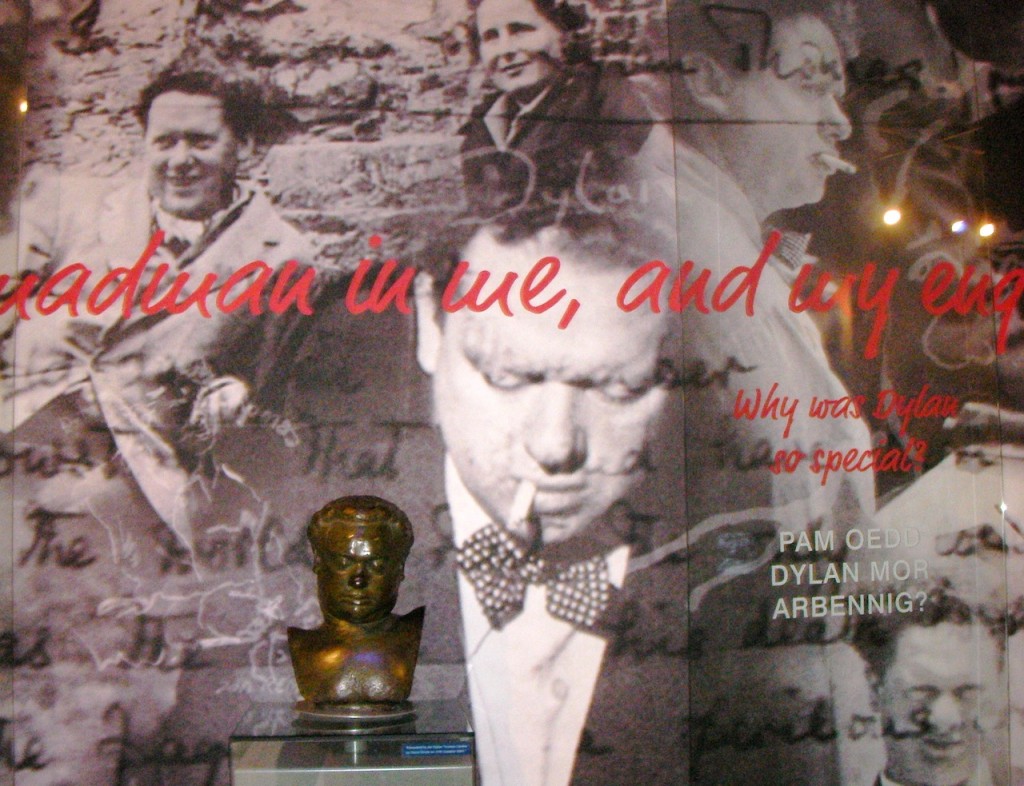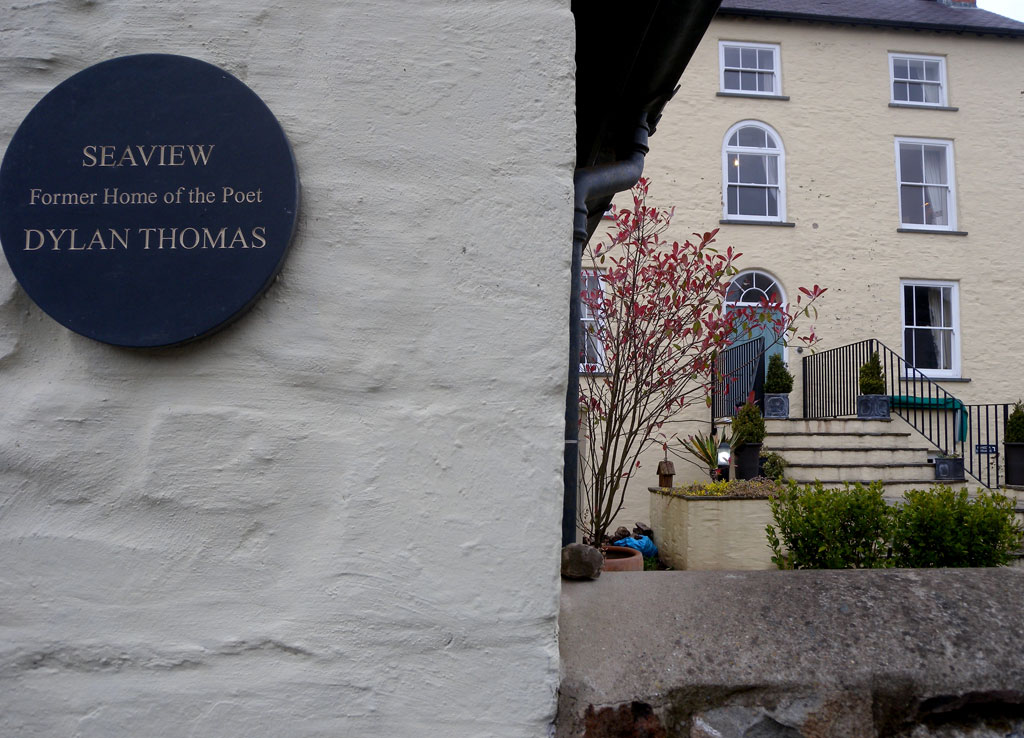* Have you signed up for my new monthly newsletter? Subscribe at the home page.
Hannah Ellis never met her grandfather but his words keep him alive to her.
She doesn’t live in Wales but his stories, writings and recordings regularly take her, and many others, back to the country lanes and tight-knit communities of West Wales he inhabited.
Hannah’s grandfather is the firebrand Welsh poet, Dylan Marais Thomas [pictured above at Swansea’s No SignBar].
“There is such warmth and passion for my grandfather’s work,” says the diminutive mother of one with her mane of curly ringlets passed down through the family.
“I want his legacy to inspire young people to find their own creative voice.”
I first met Hannah at a glitzy party at the National Museum of Wales in Cardiff.
It was the opening night of an exhibition of images inspired by Dylan’s work by the British pop artist Sir Peter Blake, the first in a year-long programme of cultural events to mark the centenary of Thomas’ birth – October 27, 1914.
She was clutching a glass of champagne amid the press photographers and the art-critic chin-stokers, pondering what her grandfather would have made of all the fuss.
“My grandfather started the legend of Dylan Thomas as the bohemian poet but that role wasn’t the real Dylan Thomas.”
“For me, he was a shy man, sat in Browns Hotel in Laugharne, Carmarthenshire, with a pint of bitter, listening to the local gossip,” adds Hannah, who lead walking tours of Dylan’s Laugharne as part of Literature Wales’ Dylan Odyssey walks.
Each tour focused on different eras of Dylan’s story form his Swansea childhood, via the golden years of creativity in West Wales to his untimely death on a reading tour of America on November 9, 1953, just as his signature work, Under Milk Wood, was just starting to attract critical plaudits.
Famous footsteps
For visitors to Wales keen to walk in Dylan’s footsteps, and to understand more of the sensitive family man behind the hard-drinking and wild-living myths, the classic pilgrimage starts at a small suburban house in the Uplands district of Swansea, a place the poet famously branded an “ugly, lovely town”.
Today local entrepreneur, Geoff Haden, runs the house as a quirky guesthouse and cultural centre.
He has restored the property to its 1914 finery with period furnishings and encourages house guests to soak up the war-era ambiance, although central heating now replaces coal fires and electricity replaces gas lamps as a concession to home comforts.
“The house was an anchor in his life. It kept him grounded but, like many young men, he also reacted against it,” explains Geoff, straining loose-leaf tea in the parlour and pouring the milk into dainty Victorian teacups.
Across town in Swansea Bay, the Dylan Thomas Centre hosts the annual Dylan Thomas Fringe Festival each autumn.
While the permanent exhibition traces his life story, more evocative is a series of recorded readings, including Thomas himself reading Do Not Go Gentle Into That Good Night, the celebrated paean to his dying father.
The former festival organiser David Woolley says:
“Thomas is the artists’ artist. All the painters and photographers of his age wanted to capture his image.”
“Thomas fell out of favour for a couple of decades but there’s now a whole new generation of writers, such as the Welsh poet Owen Shears, who are embracing his legacy and adapting it for their own voice.”
Prodigal return
Thomas left Swansea to flex his artistic muscles, living an itinerant life for years between London and Wales. But he eventually made a prodigal return, settling in a creeky old boathouse Laugharne.
He spent the final, and most productive years, of his life here, living with his wife Caitlin Macnamara and their three children from 1949 to 1953.
Today Laugharne, a cluster of stone-built cottages some eight miles from Carmarthen along winding, country lanes, is the beating heart of the nostalgia trail.
It is home to the annual Laugharne Weekend arts festival and Browns Hotel, his erstwhile favourite drinking den, recently re-opened as an upmarket hotel and bar following a £2m refurbishment.
I pick up the Thomas trail at The Grist, the makeshift town square with its ancient cross and views across to Laugharne’s 12th-century castle – “brown as owls” according to Thomas.
I take the coast path beside the estuary, now part of the Wales Coast Path, and edge along the moss-carpeted trail, a cluster of steep, stone-built steps descending dramatically to the beach below.
This leads to the garage, which Thomas used as a writing shed.
It was here, with views across the “heron-priested shore” that Thomas indulged in his “craft or sullen art”, penning some of his best-loved poetry, including Poem in October. With its discarded, scrunched-up papers and pools of fountain pen ink, it looks as if he had just popped out for a quick breath of fresh, sea air.
The Boathouse, the former family home, has a range of exhibits drawn from Thomas’s career, while a mock-up of the family’s erstwhile front parlour features family photographs that explore the quieter side of Thomas away from the bravado of the literary poster boy.
Downstairs, the bookshop is doing a brisk trade in copies of his works. I pick up an illustrated copy of A Child’s Christmas in Wales for my own children before heading on.
Later that day I call into Corran Books, an antiquarian bookshop with a labyrinthine collection of dust-covered books, to find the ruddy-faced owner, George Tremlett, who has lived in Laugharne since 1982 and wrote the autobiography of Thomas’ widow, Caitlin (Secker & Warburg, 1986).
For him, living in the eye of the storm in Thomas’ centenary year, the trails and events are a welcome celebration but visitors should read the work to truly understand the man.
“Thomas evokes something in me – even at my age he makes me cry,” says George, looking across to the lunchtime drinkers at Browns Hotel opposite. “He never tried to be contemporaneous.”
“He wrote about the great answerable questions in life and that’s why his work has become part of national heritage.”
Both Dylan and Caitlin are buried in the graveyard of St Martin’s Church in Laugharne, the latter joining her late husband in the flower-strewn plot in 1994.
The graves are marked with a simple white cross and offer eternal views across the rolling hills of Carmarthenshire. In the cold-stone interior of the church, meanwhile, a plaque to Thomas bears the inscription from one of his most evocative poems, Ferne Hill. It reads:
“Time held me green and dying. Though I sang in my chains like the sea.”
* This store was originally published in the spring 2014 issue of Journeys Magazine under the headline, Literary Legend.
Liked this? Try this: At home with Dylan in Swansea.
Post your comments below.




